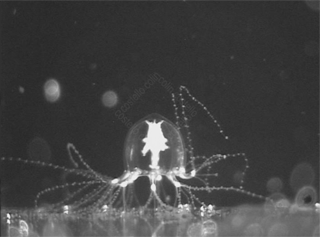The widespread occurrence and frequent abundance of small hydromedusae suggests that they may play an important role in planktonic communities. However, rather than exhibiting dominant impacts on any specific planktonic group, field studies have demonstrated diverse dietary niches and only modest trophic impacts by small hydromedusae. To understand the functional bases for these patterns, we exposed two hydromedusae (Cladonema californicum and Leuckartiara sp.) to a variety of prey types (dinoflagellates, rotifers, barnacle nauplii, copepods and the hydromedusa Obelia sp) while video-recording predation sequences (encounter, capture, ingestion). Both C. californicum and Leuckartiara sp. ambush prey and possess penetrating nematocysts (stenoteles and euryteles, respectively). Although similar prey selection patterns might be expected based on encounter models or nematocyst complements, the two species exhibited some markedly different ingestion patterns. For example, C. californicum positively selected copepod prey and negatively selected hydromedusae, whereas Leuckartiara sp. exhibited the opposite pattern. Quantification of predation sequences demonstrated that hydromedusan dietary variations resulted from species-specific differences in frequencies of prey capture as well as post-capture transfer to the gut. Species-specific prey selection patterns and limited ingestion capacities may explain the diverse prey selection patterns and limited trophic significance observed in field studies of ambushing hydromedusae.
Regula, C., Colin, S. P., Costello, J. H., Kordula, H. In Press. Mechanisms of prey selection in ambushing hydromedusae. Mar. Ecol. Prog. Ser.

Paper Coming Soon!
Video (click thumbnail):

Feeding behavior of the ambush foraging medusa Cladonema californicum. Cladonema attaches itself to a substrate to feed but just like other ambush foragers, it extends its tentacles out waiting for unsuspecting prey to swim into its tentacles. If the prey is recognized as food then the nematocysts (see figure below) located along the tentacles fire and capture the prey. The prey can then be transferred to the manubrium inside the bell to be ingested. The video shows two Artemia (brine shrimp) being captured. (Quicktime File 8,944 KB)
Figures:
Fig. 1. Illustrations of Cladonema californicum (3 mm diameter) and Leuckartiara sp. (6 mm diameter) in their feeding posture.
Fig. 2. Observed sequence of events during the feeding process of Cladonema californicum and Leuckartiara sp. and illustration of terms.
Fig. 3. Tentacle section of Leuckartiara sp. with uniformly distributed undischarged eurytele nematocysts (two are indicated by arrows). Discharged (B) eurytele nematocyst of Leuckartiara sp. and discharged (C) stenotele and (D) desmoneme of Cladonema californicum. (E) Tentacle section of Cladonema californicum with undischarged stenotele (b) and desmoneme (c) nematocysts arranged in batteries along the tentacle. Euryteles and stenoteles are thought to penetrate prey and desmonemes are thought to entangle prey.
 Jellyfish ambush predation
Jellyfish ambush predation






